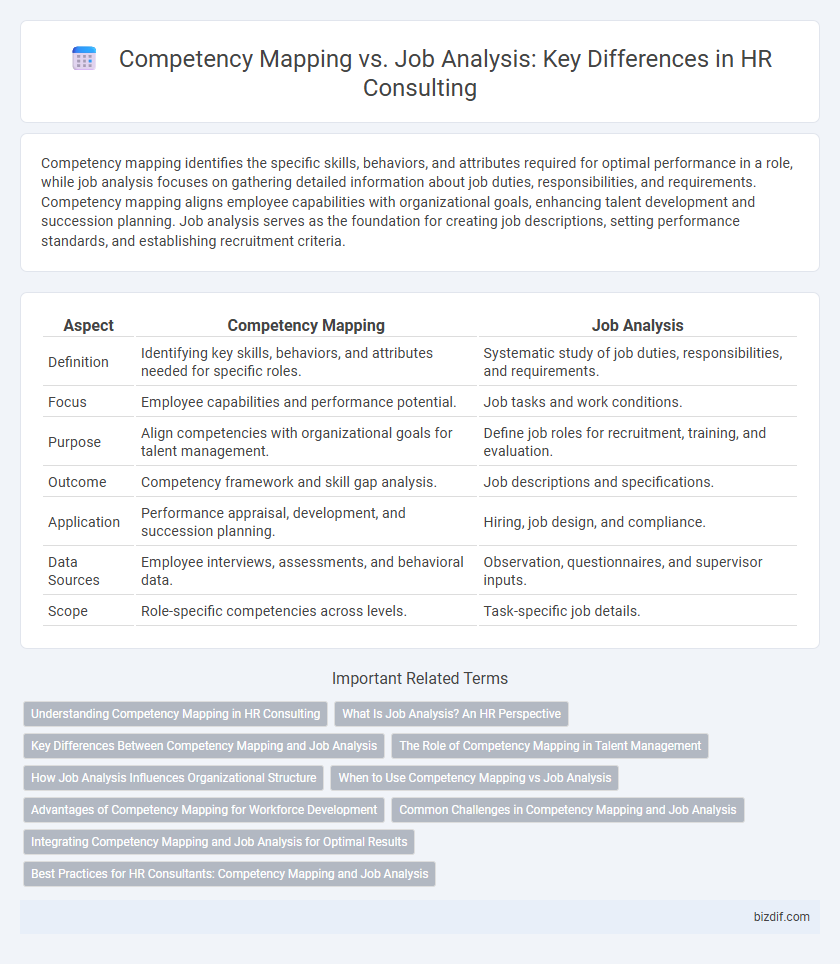Competency mapping identifies the specific skills, behaviors, and attributes required for optimal performance in a role, while job analysis focuses on gathering detailed information about job duties, responsibilities, and requirements. Competency mapping aligns employee capabilities with organizational goals, enhancing talent development and succession planning. Job analysis serves as the foundation for creating job descriptions, setting performance standards, and establishing recruitment criteria.
Table of Comparison
| Aspect | Competency Mapping | Job Analysis |
|---|---|---|
| Definition | Identifying key skills, behaviors, and attributes needed for specific roles. | Systematic study of job duties, responsibilities, and requirements. |
| Focus | Employee capabilities and performance potential. | Job tasks and work conditions. |
| Purpose | Align competencies with organizational goals for talent management. | Define job roles for recruitment, training, and evaluation. |
| Outcome | Competency framework and skill gap analysis. | Job descriptions and specifications. |
| Application | Performance appraisal, development, and succession planning. | Hiring, job design, and compliance. |
| Data Sources | Employee interviews, assessments, and behavioral data. | Observation, questionnaires, and supervisor inputs. |
| Scope | Role-specific competencies across levels. | Task-specific job details. |
Understanding Competency Mapping in HR Consulting
Competency mapping in HR consulting involves identifying and evaluating the specific skills, behaviors, and attributes required for optimal job performance. It provides a detailed framework that aligns employee capabilities with organizational goals, enhancing talent management and development strategies. Unlike job analysis, which focuses on job duties and requirements, competency mapping emphasizes the underlying competencies that drive successful outcomes.
What Is Job Analysis? An HR Perspective
Job analysis is a systematic process used by HR professionals to identify and document the specific tasks, responsibilities, skills, and qualifications required for a particular job role. This process provides critical data for developing job descriptions, setting performance standards, and designing training programs. By capturing detailed insights into job functions, job analysis supports effective recruitment, compensation strategies, and workforce planning in organizations.
Key Differences Between Competency Mapping and Job Analysis
Competency mapping identifies the specific skills, behaviors, and attributes required to perform roles effectively, focusing on personal and professional characteristics, while job analysis emphasizes detailed tasks, duties, and responsibilities associated with a position. Competency mapping aligns closely with organizational goals and development plans, aiding in talent management and performance improvement, whereas job analysis provides foundational data for job descriptions, recruitment, and compliance. Both processes support HR functions but address distinct aspects of workforce planning and employee development.
The Role of Competency Mapping in Talent Management
Competency mapping plays a critical role in talent management by identifying the specific skills, behaviors, and attributes required for optimal performance within roles, enabling precise alignment of employee capabilities with organizational goals. Unlike traditional job analysis, which focuses primarily on job duties and responsibilities, competency mapping emphasizes the underlying qualities that drive success and growth potential. This targeted approach facilitates effective recruitment, training, and career development, enhancing workforce productivity and retention.
How Job Analysis Influences Organizational Structure
Job analysis systematically gathers information about job roles, directly impacting organizational structure by defining clear duties, responsibilities, and reporting relationships essential for efficient workflow design. This process identifies skill gaps and role overlaps, enabling HR consultants to recommend structural adjustments that enhance productivity and clarify hierarchical levels. Integrating job analysis data ensures alignment between employee capabilities and organizational goals, driving strategic staffing and optimal resource allocation.
When to Use Competency Mapping vs Job Analysis
Competency mapping is ideal when organizations aim to identify specific skills, behaviors, and attributes required for effective performance within roles, often used in talent development and succession planning. Job analysis is more suitable for detailed documentation of job duties, responsibilities, and requirements, typically applied in recruitment, job design, and compliance. Use competency mapping to align employee capabilities with strategic goals, while job analysis supports workforce planning and legal compliance.
Advantages of Competency Mapping for Workforce Development
Competency mapping offers targeted insights into employee skills, enabling precise identification of training needs that align with organizational goals. It fosters a strategic approach to workforce development by highlighting behavioral attributes and core competencies essential for high performance. This method enhances talent management processes such as recruitment, succession planning, and career development, leading to improved organizational agility and employee engagement.
Common Challenges in Competency Mapping and Job Analysis
Common challenges in competency mapping and job analysis include accurately identifying and defining required skills, behaviors, and qualifications to align with organizational goals. Both processes often face difficulties in gaining stakeholder consensus and ensuring data consistency across various job roles. Additionally, updating competency frameworks and job descriptions to reflect evolving business needs demands continuous effort and resource allocation.
Integrating Competency Mapping and Job Analysis for Optimal Results
Integrating competency mapping and job analysis enhances HR consulting by aligning job roles with the specific skills and behaviors required for success, leading to precise talent identification and development. Competency mapping focuses on the attributes and capabilities employees must demonstrate, while job analysis provides detailed information about job responsibilities, tasks, and required qualifications. This integration enables organizations to create targeted training programs, improve recruitment accuracy, and optimize performance management systems for sustained organizational growth.
Best Practices for HR Consultants: Competency Mapping and Job Analysis
Competency mapping and job analysis are essential HR consulting tools that identify key skills and responsibilities to optimize talent management and workforce planning. Best practices for HR consultants include using competency mapping to align employee capabilities with organizational goals, while conducting thorough job analysis to define roles, performance standards, and recruitment criteria. Integrating both approaches enhances hiring accuracy, employee development, and overall organizational effectiveness.
Competency Mapping vs Job Analysis Infographic

 bizdif.com
bizdif.com